|
The Good Old Days of the Opera House
There are few memories that bring more pleasure than
those of the days of the Opera House. The people who remember talk of its
past with fondness.

Known also as the Roper Block, the Opera House was
built in the 1850’s by Mr. Bryant, the same Mr. Bryant who owned the
tavern Ranald McKinnon came upon when he first came to the area. The Roper
Block was built on the property at the northeast corner of Argyle and
Caithness Streets. It was a magnificent structure and with three storeys
it was the largest building in Haldimand County. The
lower floor held stores of business: a barber shop, F. Simpson Variety
Store, M.E. Forster Variety, the Roper Drug Store, the Bank of Hamilton
and others. The second floor contained the huge concert hall with the
Harrison Arrell Barrister office occupying one end from 1905 to 1932. The
third floor was a lodge hall for the St. Andrews Lodge and the Caledonia
Chapter 236.
Vaudeville shows, Chautauqua shows and other travelling
road shows entertained in the Opera House, attracting crowds from a wide
area. One person remembered, as a small boy, attending a performance of
the week-long roadshow production of "Uncle Tom’s Cabin". For many,
it is the big band ballroom dances which hold the
fondest and richest memories. It was a common occurrence to break up a
chair to re-kindle the fire when it was necessary.
It was also common knowledge that the vibration from dancing knocked items
from the shelves of the variety store below. Rods were finally strung
across the ceiling of the basement to cut down the impact created by the
enthusiastic dancers.
Election times found the opera hall much in demand.
This was by far the best place to see and hear the political party
leaders. Huge Haldimand County crowds came in droves to support or revile
the leaders of the day.
St. Paul’s Anglican Church held a celebration for its
75th Anniversary in the Opera House on January 25th, 1926.
Four hundred people sat down to dinner in the concert hall, all
decorated in pink and green. In the centre of the head table stood a five
storey birthday cake, illuminated by seventy-five pink candles, a special
occasion for Caledonia.
The Opera House was destroyed by fire in June,
1947. The estimated damage from the fire that
brought an end to both an important landmark and social era was claimed to
be $125,000. Citizens of all ages were on hand to view the spectacular
blaze, many still in their night attire, helpless in the face of the all
consuming blaze.
The era of the Opera House in Caledonia was never to be
repeated. A two storey building with apartments on the second floor was
built at the same location in 1950.
A "Lovable" Constable
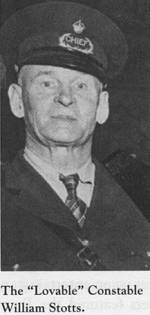 Known
as the "lovable" Constable, Bill Stotts was revered by all who knew him.
The small child he would call by name and take across the street was as
important to the Constable as were his Six Nations friends he would drive
home if they needed a ride. Known
as the "lovable" Constable, Bill Stotts was revered by all who knew him.
The small child he would call by name and take across the street was as
important to the Constable as were his Six Nations friends he would drive
home if they needed a ride.
People who remember Bill Stotts say he was gentle, kind
and courageous. At the same time, they say, he was firm. The respect he
held for his fellow man came back to him a hundred fold. The Six Nations
visitors responded to his kindness by assisting him in controlling any
troublemakers. He used discretion, not force. However, if force were
needed, he had a grip like a vice. There was no question as to who was in
control.
Constable Stotts and his wife lived on the main floor
of the Town Hall from 1937 to 1955. The jail in the basement was no longer
in use. All lock-ups by this time had to be transported to the Cayuga
jail.
Stotts worked alone, always on 24-hour
duty. As well as the policeman for the community, he
was the dog catcher, sold dog licences and returned the lost dogs
and stray cats he found to worried owners.
One story is told of three hoodlums who were about to
speed away in a stolen car when Constable Stotts stood in front of the car
with his arms out. They were handcuffed and arrested on the spot.
The traffic director for the town as well, he never
missed the duty expected for a funeral procession. His lookout point was a
small office on the corner of Argyle and Caithness street, a spot provided
by a merchant where he could be inside yet able to keep his eye on the
town streets.
When the big storm of 1945 hit
Caledonia, the roads were blocked from all directions. One night during
the extended blizzard, a baby decided to be born. The distraught parents,
unable to get their car out of the garage, appealed to Constable Stotts
for help. At five in the morning, despite all the hazards, he was able to
rescue mother from the house and get her to the hospital over treacherous
roads. In keeping with his style, he refused to take a cent, only too
happy to help. For him this gesture was an expected part of the job.
He was dependable, trusted and a friend to all. Those
who remember say Caledonia is a better place, because for a time Bill
Stotts was its protector. He died in 1959 mourned by
many. His wife Ann was remarried to W.E. Elliott of Goderich, Ontario and
in 1993 celebrated her one hundredth birthday in
Goderich.
The MacGregor Concert Bureau
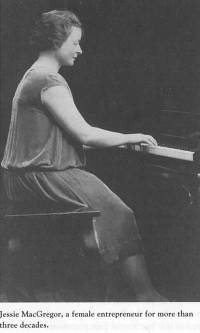 The
MacGregor Concert Bureau, an entertainment business in Caledonia, was well
known throughout Ontario during the 1920’s, 30’s and
40’s. Jessie Cameron MacGregor, a native of
Caledonia, was one of Donald and Jean MacGregor’s six children. The family
owned a hardware and insurance business in the town. The
MacGregor Concert Bureau, an entertainment business in Caledonia, was well
known throughout Ontario during the 1920’s, 30’s and
40’s. Jessie Cameron MacGregor, a native of
Caledonia, was one of Donald and Jean MacGregor’s six children. The family
owned a hardware and insurance business in the town.
Jessie, showing an early aptitude for music, studied at
the Toronto Conservatory as a student of the noted Russian virtuoso of the
day, Mark Hambourg. Her talent led to extensive postgraduate studies in
Boston. At one time she was invited to perform on the Great Organ in the
Boston Symphony Hall. By this time she had already studied with one of the
world’s great. masters, Frank Welsman, the founder of the Toronto Symphony
Orchestra and many other symphonies.
Her talent and musical encounters with the entertainers
of the time, combined with an entrepreneurial bent, prompted Jessie
MacGregor to set up an entertainment bureau in her hometown. Her
promotional book lets featured the Bureau as the source for those
committees requiring entertainment from year to year.
Organizations soon began to rely on Miss MacGregor
as a contact person who could always be counted on to deliver the
best acts available for the most reasonable price.
By 1938 Jessie had been in
business for twenty years. Her long list of entertainers included
vocalists, ventriloquists, dramatic readers, violinists, elocutionists,
pianists, drummers, xylophone players and many others. Trios, quartets and
quintets, including the Elgar Ladies, and male quartets such as The
Orpheus Male Quartet were on her roster.
Personally guaranteeing every artist sent out, the
MacGregor Concert Bureau simplified the work of those wishing to acquire
entertainment. Brochures were sent to fair boards, garden party and church
concert committees, Associations of the Eastern Star, baseball clubs, high
schools, fire departments and the list went on and on.
Those on the committee would indicate the price they
would pay for an anticipated entertainment, and whether or not the event
would be held inside or outdoors. The MacGregor Concert Bureau would
respond with a letter suggesting various combinations that might be best
suited. In the majority of cases, the selection of the artists and the
arranging of the programmes was left solely with the Bureau.
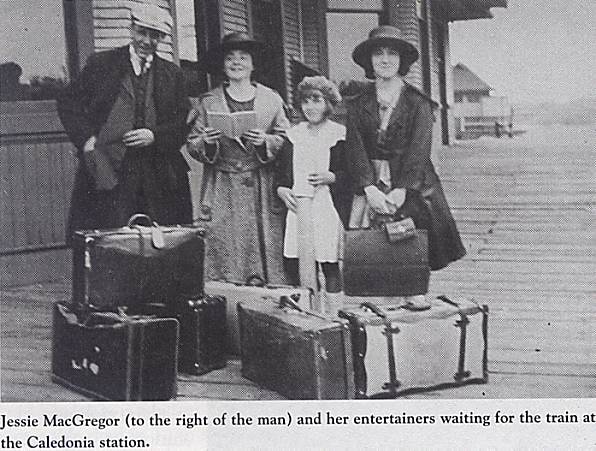
The Bureau did not claim to handle all artists in the
profession, but simply the best. First-class talent, improved service to
committees and the assurance of a square deal was the reputation built by
Jessie McGregor. In most cases Jessie herself personally directed the
productions and played the musical accompaniment on the piano.
Numerous testimonials were sent to the Bureau following
the performances and were duly printed in the Booklet of Entertainment.
One such testimonial from J.D. McCallum of the Almonte Fall Fair said,
"The three consecutive nights at the Almonte Fair Concerts under Miss
MacGregor’s direction were high-class entertainments and drew the biggest
crowds in years." Fire Chief A. Hilmer of Oakville said, "Our garden party
draws bigger crowds each year, thanks to Miss MacGregor’s excellent
judgment in choosing and presenting programmes." "Clean, wholesome
entertainment," is how Reverend B.A. Harris, of St. Patrick’s Catholic
Church in Caledonia described their event.
Jessie MacGregor held top honours wherever she went.
Her favourite pianoforte solo, the Mendelssohn Concerto in G Minor for
piano and orchestra or string quartet, was a headline performance. Her key
entertainment stage in Caledonia was the July 1 annual Garden Party held
on the outdoor platform constructed at the rear door of the Town Hall on
Edinburgh Square. The local constable, who lived on the first floor of the
building, allowed his quarters to be used for dressing rooms. Those
concerts and garden parties are likely to have included Jessie MacGregor’s
outstanding Ladies Choir of thirty-five voices which she also organized
and directed.
It was in 1925 that Ruth Rushton remembers being at a
Garden Party on Edinburgh Square. She described how Jessie MacGregor
walked out to the piano on the unadorned open air stage, music in hand, a
faint smile on her face, her bright brown eyes taking in the audience. All
of us, she recalled, sat expectantly on the pine plank seats as dusk came
on.
"The long sleeveless evening dress of brocaded satin
with modestly low neckline and her pleasingly plump arms seemed to
emphasize her hands as they moved gracefully over the keyboard." To this
young public school girl, Jessie MacGregor was a vision of beauty and
accomplishment as she accompanied the performers she had booked for the
evening’s entertainment.
"There would be a comedian, juggler, acrobat and
Scottish dancers and always a good baritone singer with the Scottish
accent to sing the old favourites by Harry Lauder and others." Jessie
MacGregor, a female entrepreneur ahead of her time, lived her life
entertaining others. She was sometimes criticized for giving young talent
too much stage time during a program, but she was never criticized for
providing an audience for talented musicians.
Throughout these years, she successfully carried on
business in a reputable fashion during the days when the competitive
Chautauqua shows were high on the list of entertainment and radio and
movies were just beginning to gain ground. After a long productive career,
Jessie MacGregor died of a cardiac seizure on July 20, 1951.
O.T. Scott
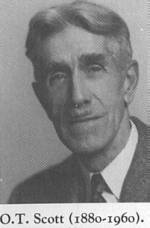 Osborne
Thomas Scott had a flare for writing poetry. His talent for rhyming verse
became a unique form of promoting and reporting community events. Much of
the history of Caledonia was recorded as a result of his sharp memory of
people and events. Osborne
Thomas Scott had a flare for writing poetry. His talent for rhyming verse
became a unique form of promoting and reporting community events. Much of
the history of Caledonia was recorded as a result of his sharp memory of
people and events.
He was the son of William Scott, a mill worker for the
McQuarrie (Daniel), Thorburn (James) and Munro (William) partnership that
owned both mills during the 1870’s. When this
partnership fell into financial trouble, the Scott brothers, William and
Hugh, took over the south mill while the north mill went to Robert Shirra.
His father, William, organized the Caledonia Milling Company in 1892 with
capital raised through shares purchased by residents of the village.
Osborne Scott, or Ob as he became known, continued to
build the company. He married Alma Doughty of Ayr, Ontario and had one
son. By 1929, the Caledonia Milling Company bought the north mill from
Shirra and remodelled it into a feed mill. The old wooden dam was
gradually replaced with a concrete dam in the mid 1930’s, financed by the
Caledonia Milling Company. By 1950, under Ob Scott’s management and along
with his son Douglas as Secretary-Treasurer, the Company realized capital
of $65,000 through stock owned by ninety-five residents of the village and
area.
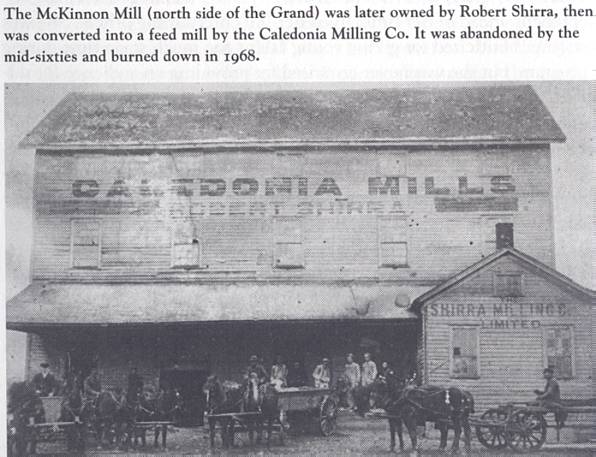
By this time there were four places of business: a
flour mill on the south side of the river, a feed mill on the north side,
a feed store at the corner of Argyle and Caithness Streets and an elevator
at the railway station.
In 1964 the charter was surrendered and the Caledonia
Milling Company, after 72 years of management by the Scott family, ceased
to exist. Osborne Scott died in 1960 at the age of eighty. His wife, Alma,
died shortly afterwards in 1962.
A Real Sweetheart: Eva Marlene Heddle
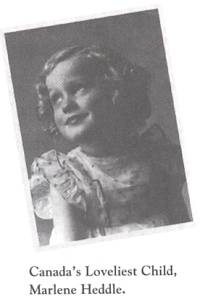 Caledonia’s
Eva Marlene Heddle made the headlines, not only in the community’s own
newspaper, but in other Canadian newspapers when she became Canada’s
Loveliest Child, the winner of a 1936 contest sponsored by the
Toronto Star. She was just three years old
when she was selected from among 11,764 other Canadian children between
the ages of three and seven. A prize of $500 went with the honour, a
considerable award for the time. Caledonia’s
Eva Marlene Heddle made the headlines, not only in the community’s own
newspaper, but in other Canadian newspapers when she became Canada’s
Loveliest Child, the winner of a 1936 contest sponsored by the
Toronto Star. She was just three years old
when she was selected from among 11,764 other Canadian children between
the ages of three and seven. A prize of $500 went with the honour, a
considerable award for the time.
It was not her mother or father who had submitted the
photograph, but her grandmother. Her parents were completely unaware that
a very proud Grandma had entered her granddaughter in the contest until
after they were advised of the win.
Reverend Norman McMillan remembers when he was called
to the Caledonia Presbyterian Church in 1939. He
didn’t know anything about the town and asked someone about this place
called Caledonia. "Oh, that’s where Canada’s loveliest child lives," the
person replied."
"When I arrived, who should be in our Sunday School but
Marlene Heddle," said Reverend McMillan. "Her grandfather, Malcolm Heddle,
had a blacksmith shop and did the ironwork on the doors of the
Presbyterian Church."
Eva Marlene Heddle with little memory of the big news,
but only stories and pictures chronicling her activities, was not affected
by the publicity that surrounded Canada’s loveliest child. She grew up and
became Mrs. Patrick Sullivan who today lives in Stoney Creek. The
scrapbook her mother made for her tells the story.
The Rt. Honourable Arthur Meighen
(1874 — 1960)
Arthur Meighen was born June 16, 1874 in Anderson,
Blanchard Township, Perth County, Ontario. His first job early in life
would later associate him with Caledonia and bring him there for numerous
functions. History books tell us Arthur Meighen taught high school for a
year after he graduated from the University of Toronto, but they don’t
tell us where. For the record, it was Caledonia. His
first job was at Caledonia High School from 1897-1898,
before he left for Winnipeg to study law. Later, in 1902 after he
completed his studies, he was called to the Manitoba bar.
Meighen was first elected to the House of Commons in
1908, appointed Solicitor General in 1913, was chief
draughtsman of the War Time Elections Act and succeeded Prime Minister
Borden in 1920. In 1921 his government was defeated. Once more in 1926 he
was invited to form a government and this time his role as Prime Minister
was even briefer, lasting for only three months.
He resigned as Conservative Leader following the
Liberal victory on September 14, 1926, but was
called to the Senate on February 3, 1932 during Richard Bennett’s
government ministry. Eventually he became leader in the Senate. In 1935
when MacKenzie King’s government took power, Meighen was Senate Opposition
Leader. Meighen thus became the only person to have headed both Government
and Opposition forces in both Houses of Parliament.
In 1941 he became leader of the Conservative party
again, but failed in his bid to win a seat in the Commons in a federal
by-election in 1942. Following this defeat, he retired from politics and
resumed his law practise in Toronto.
The Rt. Honourable Arthur Meighen was seen periodically
in Caledonia either as a guest for a special event or visiting with
friends such as Mrs. Elizabeth Trotter and family at 100 Argyle Street,
opposite the Public School. This home was sold in 1967 and later torn down
to make room for the Argyle Heights Apartments.
The Grand River
Sachem did not miss reporting on Arthur Meighen’s successes over the
years. The July 2, 1913 issue reported that he was sworn in on June
26, 1913 as Solicitor General of Canada with a
salary of $5,000 a year. It also said his appointment would be a very
popular one as Mr. Meighen was one of the brightest young men in the House
and noted that his many friends in Caledonia congratulated him on his
appointment.
Meighen came to Caledonia for two most important
occasions; the 1927 Diamond Anniversary celebration and the 1950 Haldimand
County Centennial Day. In his short address in 1950 he quipped, "Though I
spent less than two years in Caledonia it was
through circumstances beyond my control. It has been true in my life all
the really important positions were of short tenure." In a more serious
tone, he commented, "The tendency today of a great many people to want
more and to give less is robbing them of real enjoyment."
According to his students who had their own opinions of
Meighen as a teacher, it was the right decision for
him to turn to another vocation. It was in Caledonia, though, where his
first career began and ended.
Arthur Meighen died in Toronto, August
5, 1960.
Pauline Johnson: Famous Canadian Poet
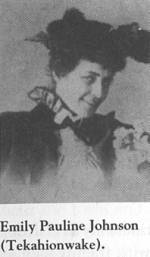 It
is well-known that Pauline Johnson is as famous in the Vancouver, British
Columbia area as she is in the Caledonia-Brantford-Ohsweken area of
Ontario where she was born and raised. Her ashes and some of her writings
were buried within sight and sound of Siwash Rock in Stanley Park, B.C. A
cairn was erected there in 1922 as a tribute to her from the Women’s
Canadian Club of Vancouver. It
is well-known that Pauline Johnson is as famous in the Vancouver, British
Columbia area as she is in the Caledonia-Brantford-Ohsweken area of
Ontario where she was born and raised. Her ashes and some of her writings
were buried within sight and sound of Siwash Rock in Stanley Park, B.C. A
cairn was erected there in 1922 as a tribute to her from the Women’s
Canadian Club of Vancouver.
Her birthplace, on the Grand River in Ontario, also
remains as a monument to her life and her work. Chiefswood, her home,
built in 1853 and bequeathed to the Six Nations
Indians in 1926, is a noted historical site and has
been a museum of period artifacts since 1963.
Chiefswood is an excellent example of the classic
Ontario plank-on-plank style. The mansion is located just west of
Caledonia on Highway 54, along the north bank of the Grand River,
overlooking the Six Nations Reserve at Ohsweken. At the turn of the
century there were many visitors to Chiefswood, then recognized as the
capital of Indian Canada. Numerous Tribal and Canadian leaders, as well as
such dignitaries as Edward VII and the Governor General of Canada were,
guests in the home of Pauline Johnson.

Pauline was born March 10, 1861 to Mohawk Chief G.H.M.
Johnson, and his wife Emily Howells, originally from Bristol, England. She
did not receive any formal education until age 16, but liked
it best when she was by herself in the woods and
fields writing poetry or paddling her canoe up and down the Grand River
drinking in the beauty of nature’s panorama. Some say it
may have been what she saw and heard at Chiefswood that inspired
her to write such romantic and soulful reflections of the Indian heart.
However, it is also known that her parents
encouraged her to write verse and ensured the presence of worthwhile books
in their home.
A story is told of Alexander Graham Bell and Pauline’s
father, George Johnson, walking through woods and fields, and up and down
slopes one day in July of 1876. They were stringing the two miles of
stovewire that led from the telegraph office in Brantford to the Bell
farmhouse. Bell, then 29 years of age, was already known for both his
success as a teacher of deaf mutes and his ideas on the transmission of
sounds.
Guests had assembled at the Bell farmhouse that day,
curious to see the latest experiment. The telegrapher at the station in
Brantford let out a whoop, "I can hear you splendidly, Professor!" Later
words came in staccato gutturals and all that came through the receiver
was something like, "Sago gatchi ska na ka," with laughter in the
background. The telegrapher responded, "Are all you fellows drunk up
there?" The answer from Bell, clear and loud was, "You’ve insulted Chief
Johnson. He’s been speaking in Mohawk."
This may have been the unofficial first instance of
long-distance talking on a telephone. The official instance between
Brantford and nearby Paris, when two telephones operated satisfactorily on
one circuit, is recorded on a plaque in Paris, dated August 29, 1877. The
fourteen-year-old Pauline was in attendance at a supper celebration
gathering for the occasion of the experiment, along with her mother and
father.
Pauline’s public appearances began in
1892. Taking after her grandfather, John Smoke Johnson and his
colourful oratory, Pauline dressed for the stage in a fringed buckskin
suit adorned with jewellery carved by Mohawk silversmiths and a scarlet
blanket thrown around her shoulders. A wampum belt, a dagger and a
necklace of the claws of the cinnamon bear and a single eagle plume
completed the outfit.
Often Pauline was described as a lyric singer of nature
and a balladist who played words like branches in the breeze. A writer of
both prose and poetry, she had a remarkable memory and charming
personality. Most notably she was a gifted elocutionist, reciting her
enthralling poems as only she could interpret them to captivated audiences
across Canada and the United States and Europe.
Her most famous work, initially recited in Toronto,
The Song My Paddle Sings, brought her fame. Sold to The Week
of Toronto for $1.00, this poem helped launch a series of recitations
that continued for some nineteen years.
Her first book, The White Wampum, was published
in England in the 1890’s during the period of her
most auspicious success. Following extensive periods of touring, Pauline
would always return to Canada where she became known as the first Canadian
woman, first Canadian Indian and first Canadian writer of international
fame. Later she settled in Vancouver, British Columbia where she did her
best writing, much of it developed from the legends
of the Squamish Reserve.
However, Pauline was not in Vancouver long before she
knew she was soon to die of tuberculosis. She passed away at the age of
fifty-two on March 7, 1913. Flint and
Feather, her best-known publication, appeared after her death.
When she died, journalist Ecclestone MacKay described
the effect of her verse in Canadian Magazine in an article entitled
"Pauline Johnson: A Remembrance": "First it brings a
breath of the woods, warm and fragrant, a breath which clutches at the
throat. . . the sound of swiftly-flowing water,
the splash of a leaping trout, the dip of a paddle. . .
And with all these lovely and familiar things it
brings also something fainter, more remote, more primitive: the
strain of an earlier, bolder, cruder race."
During her lifetime, despite her acknowledged fame, the
entire income earned from sale of her poems is reputed to have been only
about $500. Today a large plaque, unveiled May 17,
1986 stands at Chiefswood Museum in honour of the famous Canadian
poet.
Besides the memorials to her honour in Vancouver,
people in British Columbia know of her through the well-known "Pauline
Johnson" chocolates. Their popularity was described by a local person this
way: as Ganong chocolates are in eastern Canada and Laura Secord
chocolates are in central Canada, Pauline Johnson chocolates are in
Western Canada. Today the Pauline Johnson chocolates are manufactured
according to the traditional standards set by the founders in 1921.
THE CAMPER
by Emily Pauline Johnson (Tekahionwake)
Night ‘neath the northern skies, lone black, and
grim;
Naught but the starlight lies ‘twixt heaven, and him.
Of man no need has he, of God, no prayer;
He and his Deity are brothers there.
Above his bivouac the firs fling down
Through branches gaunt and black, their needles brown.
Afar some mountain streams, rockbound and fleet,
Sing themselves through his dreams in cadence sweet.
The pine trees whispering, the heron’s cry,
The plover’s passing wing, his lullaby
And blinking overhead the white stars keep
Watch o’er his hemlock bed — his sinless
sleep.
Peter Robertson, Inventor of the Robertson Screwnail
Peter Lymburner Robertson was born and raised not far
from Caledonia in Seneca township, one of a family of six children born to
John and Annie Robertson. His father would die in the Yukon in 1886,
bitten by the Gold Fever, leaving Peter’s mother to raise the family. Of
the other children, John Junior went to Nevada, Will became a doctor in
Toronto, Hutton taught school and later took up dentistry, Jessie married
and Isa remained single at least until the time she left Seneca.
Peter, a mechanically minded person with an
entrepreneurial bent, began his career as an agent or salesman. In 1907 he
established the P.L. Robertson Manufacturing Company in Hamilton. A year
later it was relocated to nearby Milton. This
company is known to be the first firm in the world to produce the square
recessed screw and the accompanying screw driver, patented in many
countries throughout the world as the Robertson screw. The Ontario
inventor used an ingenious process he had developed to punch square holes
into cold metal, then developing the innovative screw for industrial
markets. The Robertson screw is still used around the world today.
In the company’s first two decades it
steadily expanded operations and by 1930 when the last patent on
the Robertson screw and the equipment used in its manufacture expired, the
firm had already begun to diversify its products.
The very early years had been tough going. Peter’s
company had a difficult time breaking into the manufacturing field in
opposition to some large companies already positioned in the market place.
However, with his innovation and his perseverance and with support from
the emerging Ford Company standing behind him, Robertson succeeded. At one
time P.L. Robertson Manufacturing shipped a twenty-ton order of screws to
England.
On November 8, 1986, the Milton
Historical Society and the Ontario Heritage Foundation commemorated the
location on Bronte Street where, from 1908 to 1951,
Peter Lymburner Robertson invented the screw and screwdriver and went on
to achieve international manufacturing recognition. Also the financial
assistance from the Ontario Ministry of Citizenship and Culture and the
Town of Milton led to a plaque being unveiled to indicate the location on
Martin Street where Robertson lived as a life-long bachelor from
1916 until he died in 1951. Milton considers the
Seneca township-born Peter Robertson to be one of its most considerate
benefactors as well as an industrialist, inventor and author. In
1934 he wrote a remarkable book entitled The Gold
Standard which won acclaim in many circles.
The Company is now operated as Robertson Whitehouse
Company, one of the largest manufacturers in North America of light
fasteners and the original Robertson screw.
An Area Knight: Sir Byron Edmond Walker
His name was Sir Byron Edmund Walker and the nobility
honour was bestowed for distinction in the financial world. Born in Seneca
township just on the outskirts of Caledonia on October 14,
1848, he was raised on a farm as one of nine children. His parents
were Alfred E. Walker and Fanny Murton.
Walker’s financial career began in 1868 with the
Canadian Bank of Commerce. At the age of twelve he left school to work in
his uncle’s bank in Hamilton. Thirty years later he became President of
the bank and retained this position until he died in Toronto on March 27,
1924, at the age of seventy-six.
While an authority on banking, he was also extensively
interested in the humanities and in particular, in heritage. He wrote a
history of Canadian banking and many pamphlets on related subjects. To
this day his name is listed by the Champlain Society as its first
president (1905-1925) and a founding member in 1905. He was also one of
the founders and prime backers of both the Toronto Art Gallery and the
Royal Ontario Museum. The list of public involvement goes on and on, from
being a board member of the Toronto Conservatory of Music in 1901, being
an Honorary President of the Mendelssohn Choir from 1900 - 1924, to his
role as the President of the Royal Canadian Institute in 1898. As well, he
had the distinction of being the financial mentor to the Right Honourable
Sir Robert Borden.
Sir Edmund helped found the Round Table Quarterly
to promote discussion of imperial issues. He was knighted by King
George V in 1910. Joseph Schull’s Ontario Since 1867
quotes Sir Edmund Walker as President of the Bank of Commerce
in 1913. At that time roads were built for horse and buggy use and
automobiles were slowly winning grudging acceptance. Sir Edmund, a true
financier, said, "If we had good roads in Ontario people would come in
increasing numbers from the United States. . .
there is no question of an increase in the number of motors so great that
we would soon be issuing 20,000 licenses for cars. .
.say at $25 each. . . $500,000
— quite a contribution." One of those bad roads
he spoke of would have been the plank road from Hamilton to Port Dover
which by that time had been covered with six feet of gravel.
At the same time, he opposed the policy of free trade
with the U.S. as announced by the Sir Wilfrid Laurier government because
he felt it would weaken ties with Great Britain.
History tells us that this surge of Imperialism expressed in Canada led to
the defeat of the trade agreement and ultimately the government.
Sir Byron Edmund Walker, not generally recognized as a
Caledonia boy, was a leading citizen of Canada in his day. His foresight
and supportive initiatives were in many instances responsible for some
exceptional institutions that are still a prominent part of our society
today.
Married to Mary Alexander, daughter of Alexander
Alexander of Hamilton, he had four sons and three daughters. Sir Edmund
Walker’s distinguished career ended with his death in 1024.
William Doyle
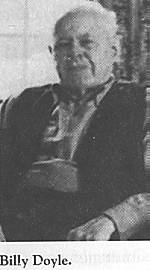 A
walking encyclopedia was how one person described William (Billy) Doyle.
At age ninety-one in 1956 he had recollections that
went back to the 1870’s when he was a young boy. He was named for his
father, William Doyle, who had been the constable in Caledonia from
1871 to 1878. Billy remembered the flour mill in
Caledonia and Chris Young’s Seneca House in Seneca Village. He also
recalled that in the post-navigation days, there were two shipping wharves
and a warehouse just east of the bridge on the north bank, as well as a
wharf west of the bridge and another warehouse and wharf on the south side
of the river. A
walking encyclopedia was how one person described William (Billy) Doyle.
At age ninety-one in 1956 he had recollections that
went back to the 1870’s when he was a young boy. He was named for his
father, William Doyle, who had been the constable in Caledonia from
1871 to 1878. Billy remembered the flour mill in
Caledonia and Chris Young’s Seneca House in Seneca Village. He also
recalled that in the post-navigation days, there were two shipping wharves
and a warehouse just east of the bridge on the north bank, as well as a
wharf west of the bridge and another warehouse and wharf on the south side
of the river.
Billy Doyle was in the McKinnon Woollen Mill in 1881
when it burned. He claimed then and repeated
it in 1956 that
it was burned on purpose. Mr. McKinnon had died in
1879 and he claimed the mill was being operated by people he
regarded as crooks.
In 1885 Doyle read of his own death in The Sachem.
At the time he was working on bridge construction in Northern Ontario
where there had been an accident. Fortunately he had not been involved.
Billy Doyle died February 16, 1963 in his ninety-ninth
year in Pomino, New York. His daughter, Margaret O’Rourke, lives in
Caledonia, but all other members of his family live in New York State.
Bruce E. French
 Bruce
French’s keen interest in the community led him to compile the first
detailed history of Caledonia in 1927, in time for the Diamond Anniversary
of Confederation. He had taught school in Cayuga before buying R. E.
Walker’s hardware business which occupied the building still standing on
the southeast corner of Caithness St. and Argyle. He remained in business
from 1905 until 1942 when the store was sold to H.S. Merrell. A prominent
citizen of Caledonia during his years in business, Bruce French is said to
have been a "real gentleman". There weren’t many organizations and
community events where he wasn’t listed as an officer or volunteer. Bruce
French’s keen interest in the community led him to compile the first
detailed history of Caledonia in 1927, in time for the Diamond Anniversary
of Confederation. He had taught school in Cayuga before buying R. E.
Walker’s hardware business which occupied the building still standing on
the southeast corner of Caithness St. and Argyle. He remained in business
from 1905 until 1942 when the store was sold to H.S. Merrell. A prominent
citizen of Caledonia during his years in business, Bruce French is said to
have been a "real gentleman". There weren’t many organizations and
community events where he wasn’t listed as an officer or volunteer.
The 1927 history, entitled A Short Historical Sketch
of Caledonia was written when he was Reeve of Caledonia. The
history’s intricate detail spanned the years from 1784
through to 1927, taking column after column of space in The
Grand River Sachem’s special souvenir edition. Authors of histories
since then have referred to these columns, truly a remarkable contribution
to the maintenance of our sense of history. Unfortunately, ill-health
prevented his completion of a history on St. Paul’s Anglican Church. Bruce
French passed away, leaving his wife Flo, the former Florence Lawson.
She remained in their home at the northeast corner of
Edinburgh Square until her death in the early 1980’s
at ninety-six years of age. She too, retained memories of the community
and often was called upon to relay them for historical purposes. The
family home stands on part of the property where Scott’s Iron Foundry
stood from 1850 - 1880.
Following the death of their daughter Helen, in
November 1989, the estate opened the home to the public by selling the
family belongings in a public auction. The antique furniture, books and
fine china attracted dealers and citizens from miles around. One piece of
furniture was identified as to having come from the John Builder Furniture
Factory, a business in Caledonia in 1866. Today the home is in private
hands, the former belongings and treasures from Caledonia scattered across
Ontario and perhaps beyond.
Mrs. Fleming’s "English Pink Ointment"
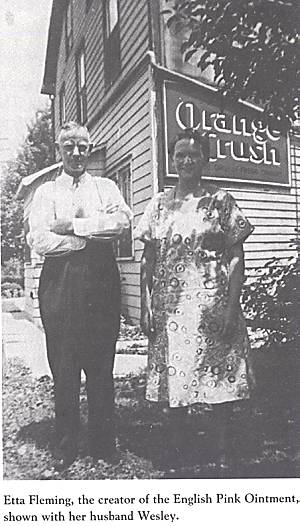 Etta
Fleming did not need advertising to sell her sought-after product. It was
more popular than the best on the market. Patented in 1931, Etta
manufactured her home recipe for a healing salve under the
label "English Pink Ointment" for almost thirty years. An old family
recipe passed down for generations in England on her husband Wesley
Fleming’s side, Etta was responsible for its popularity in Canada’s
Caledonia area. Etta
Fleming did not need advertising to sell her sought-after product. It was
more popular than the best on the market. Patented in 1931, Etta
manufactured her home recipe for a healing salve under the
label "English Pink Ointment" for almost thirty years. An old family
recipe passed down for generations in England on her husband Wesley
Fleming’s side, Etta was responsible for its popularity in Canada’s
Caledonia area.
She ordered the ingredients, the small one-ounce tins
and the labels from Boose’s Drug Store. Stan Parke, a former druggist,
remembers that customer’s claimed that Mrs. Fleming’s ointment was
faster-acting than Mecca or the Zambuck salve. Once she had made the
English Pink Ointment and carefully packaged it,
Etta would sell her product back to the drugstore for availability to
customers.
Frankie Szabo, her son-in-law, said she didn’t make a
great deal of money on "E.P.O.", as it became known,
but kept making it to accommodate the customers who
wouldn’t be without it. In the 1940’s the ointment
sold for 50 cents at the drugstore. "Once she got older, she had me stir
and mix it for her," Frank said. Etta’s recipe has
been passed down and is recorded as follows: 2 — 1
lb. tins of white petroleum (vaseline); 2 1/2 oz. olive oil; 2 tsp. oil of
thyme; 4 oz. calamine; 2 oz. of mercury red oxide
granulated. Mix and stir.
It was the drawing power of the recipe that gave the
ointment the healing quality for sores, cuts, bums and scratches. For
boils, it was the answer to drawing out the core.
The value of the ointment went beyond people to become a local remedy for
horses and other domestic animals.
Etta, her husband Wes, and their two daughters lived in
the Seneca Village area at 696 Caithness St. East during the 1930’s and
40’s. Later they would move to the south side of the river. At one time,
they lived in the Richardson (Haldimand House) apartment complex. Etta
died in August, 1977 at a Hagersville nursing home where she and her
husband had lived for sometime. She was eighty-eight years old.
He Walked Alone
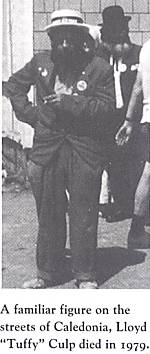 His
name was Lloyd A. Culp, but the community knew him as "Tuffy". His sense
of priorities were different from those of the average person, but then as
one might put it, who are we to say he was wrong and
we were right. His free spirit allowed him to enjoy life as he lived
it. He was one of four children born to Bill and
Lizzie Culp, the one who decided to live life differently. His
name was Lloyd A. Culp, but the community knew him as "Tuffy". His sense
of priorities were different from those of the average person, but then as
one might put it, who are we to say he was wrong and
we were right. His free spirit allowed him to enjoy life as he lived
it. He was one of four children born to Bill and
Lizzie Culp, the one who decided to live life differently.
Tuffy lived a good mile or more away from the centre of
town, but would be seen daily with at least two suits of clothing, winter
or summer, usually pulling his wagon. If the business people didn’t see
him for a day or two, there would be concerns about his whereabouts and
well-being.
Earl Gillespie’s residence was about halfway between
Tuffy’s home and the downtown area. Tuffy would call in almost every day
to get a drink of water. Eventually the Gillespies put a glass by the
outside tap ready for his visit just in case he called when no one was
home.
Tuffy was known to be a gentleman. He was always polite
unless provoked. He usually played along with any teasing, but if
it got out of hand he would be upset. He was fair,
honest and appreciative of any kindness. He knew who his friends were and
would call on them for help when needed. One such friend remembered Tuffy
borrowing $2.00 until his cheque came in. When he couldn’t pay
it back at the time promised, he went to his lender
to tell him he just didn’t have the money. It was a month before
it was paid back, but Tuffy hadn’t forgotten. This
isn’t an unusual story, it’s one that is told often
by different people.
Fair time was looked forward to by Tuffy. That was one
of the many times during the year he would enter the Sachem office without
a hello and walk straight back to his friend Harrison Martindale in
the print shop, to ask for the list of Fair dates. He wanted to be ready
for his job with the Marshall concession where he peeled potatoes. Tuffy
travelled with the Marshalls from fair to fair, including the one at
Caledonia. In his younger days, at haying time he would work for some
farmers in the area, and according to those who hired him, did a good days
work.
The doctors would also look after Tuffy. He was
confined to hospital on more than one occasion. The last time was just
before his death when a terminal illness kept him hospitalized for some
time. Lloyd died November 22, 1979.
Harrison’s poetic prose led him to write an obituary
about his friend to mark the end of an era. Familiar individuals such as
Tuffy were to be no longer part of a town’s makeup. Harrison writes, "Tuffy'
as he was affectionately called by all who knew him was a familiar figure
in our community. He was known to almost everyone in Caledonia, especially
the children in our town."
"Lloyd never owned an automobile of any kind but his
wagon was just as important and dear to him as if it
had been a shiny limousine. It was the finest wagon in town, complete with
license plates, rubber tired wheels and safety reflector mirrors. His
wagon was a part of his life and it followed him
wherever he went, and it was often seen parked on
the sidewalk on our main street.
"No doubt there were often times when Lloyd felt
rejected by our modem day society and his loneliness was always hidden
from the eyes of the busy passerby.
"We knew Lloyd CuIp to be an honest man; a man who knew
no violence and profanity which held no place in his conversation.
"Our old friend will not be remembered for his monetary
or material possessions, but rather he will be remembered as a familiar
figure who walked alone, without malice or bitterness, and demanding so
very little from the world in which he lived."
The Six Nations Artist
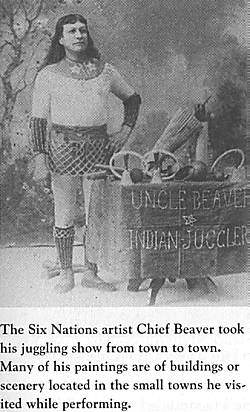 Known
as "The Six Nations Artist", Chief Beaver travelled the Grand River from
Caledonia to Brantford in the 1890’s, painting
houses and business buildings for a living. During his life span from
1846 to 1925 he lived at Beaver’s Corners near
Ohsweken on the Six Nations Reserve. A gifted man of many talents, he was
known as a carpenter, a wood-carver, a juggler and a showman, as well as a
painter. Known
as "The Six Nations Artist", Chief Beaver travelled the Grand River from
Caledonia to Brantford in the 1890’s, painting
houses and business buildings for a living. During his life span from
1846 to 1925 he lived at Beaver’s Corners near
Ohsweken on the Six Nations Reserve. A gifted man of many talents, he was
known as a carpenter, a wood-carver, a juggler and a showman, as well as a
painter.
On stage, he was "Uncle Beaver" as he travelled across
Canada and the United States with road shows, carnivals and medicine men.
Today some homes on the Reserve still retain samples of his woodworking
and fine carpentry skills.
Jim Beaver and his wife, Lydia (Bay) from a Mohawk
Reserve in Quebec, raised three sons and four daughters. Granddaughter
AIta Doxtador remembered being impressed by a concert her grandfather put
on in Christ Church at Beaver’s Corners and the canvas backdrops he
painted for the occasion. She also remembered seeing him seated in front
of his easel. Because he couldn’t read or write, he once asked her to
write TITANIC on a paper for his painting of a ship.
Mrs. Emily Ames, the daughter of H.B. Sawle, one-time
publisher of The Sachem,
remembered Chief Beaver asking to paint the Sachem building for a sum of
money. She and her sister (Mrs. Harrison Arrell) were very young when they
posed with the rest of the family in front of
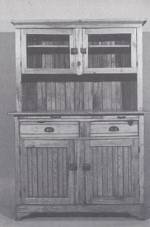 the
building in 1892. That particular Chief Beaver
Painting hung in the Sachem office until the early 1980’s when it
was later donated by the Martindale family to Edinburgh Square Heritage
and Cultural Centre where it hangs today. Because of its historic
significance to the area, full government funding by the Ministry of
Citizenship and Culture enabled the restoration of this important piece of
art to take place. the
building in 1892. That particular Chief Beaver
Painting hung in the Sachem office until the early 1980’s when it
was later donated by the Martindale family to Edinburgh Square Heritage
and Cultural Centre where it hangs today. Because of its historic
significance to the area, full government funding by the Ministry of
Citizenship and Culture enabled the restoration of this important piece of
art to take place.
Today Chief Beaver’s paintings are valuable. Numerous
residents were offered large sums of money for their Beaver originals some
fifteen years ago. Edinburgh Square Heritage and Cultural Centre has two
Chief Beaver originals; the "Three Sister Mountains" and the "Sachem
Newspaper Office". The Iroquois Indian Museum in New York State also has a
number of Chief Beaver originals as does the Woodland Cultural Educational
Centre in Brantford. |
